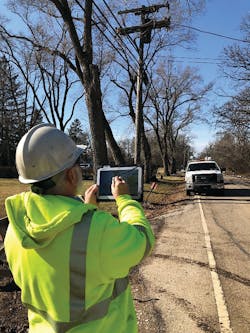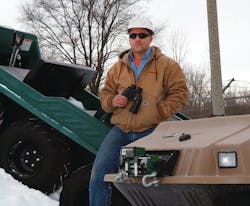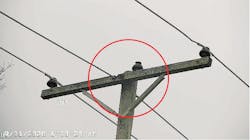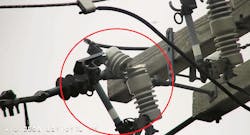ComEd Intensifies Focus on Inspections
As part of its reliability strategy, Commonwealth Edison Co. has been laser focused on its inspections process to identify faulty equipment faster and earlier. Passage of landmark legislation in Illinois, such as the Energy Infrastructure Modernization Act (EIMA) in 2011 and Future Energy Jobs Act (FEJA) in 2016, has enabled Commonwealth Edison (ComEd) to invest in upgrades to its aging T&D assets.
As a result, the utility has improved overall reliability by more than 70% since 2012 based on a combination of the system average interruption frequency index (SAIFI) and customer average interruption duration index (CAIDI). When comparing its 2019 performance to its five-year (2007-2011) pre-EIMA average, SAIFI improved by 47% and CAIDI by 52%. ComEd delivered its best reliability on record in 2019, with over 80%, or 3.2 million, of ComEd customers experiencing either zero or one interruption. This the utility’s best performance on record, contributing to an overall reliability rate of 99.99%.
However, this progress only represents the beginning of ComEd’s reliability journey. The utility still must address significant material condition and resiliency needs for critical equipment across its infrastructure base. Past smart grid investments only partially addressed these needs by focusing on the most critical issues on the grid. The outbreak of the novel coronavirus increased the urgency with which ComEd needs to address the other significant issues on its grid.
Risk-Based Programs
Serving more than 4 million customers across more than 400 municipalities, including the city of Chicago, Illinois, U.S., ComEd conducts inspections and prioritizes corrective maintenance work identified from the inspections based on the impact to its reliability. The utility performs routine preventive maintenance inspections for equipment such as overhead circuits, padmounted transformers, manual switchgear and automatic throw-over (ATO) switchgear at routine intervals. These inspections and follow-up corrective maintenance greatly reduce the likelihood an equipment failure will cause a customer interruption.
The circuit inspection program provides a visual assessment of the physical condition of ComEd’s overhead distribution and sub-transmission system. The 12-kV and 4-kV circuit inspections are performed on a two-year cycle for the three-phase main lines and a four-year cycle on fused taps. The 34-kV circuit inspections are performed on a two-year cycle while the 69-kV inspections are performed annually. The overhead circuit inspections include a review of equipment such as cross arms, pins, arm braces, lightning arresters, disconnects, cutout fuses, connectors, insulators, cable terminations, pole grounding, fault indicators and guying.
The circuit thermography program provides an infrared assessment of ComEd’s overhead distribution and sub-transmission system to identify any hot spots. All issues are captured and noted for further investigation and repairs through ComEd’s corrective maintenance (CM) program. They are prioritized based on the extent of damage and potential reliability impact. In urgent cases, repairs are performed within 24 hours. Other repairs are scheduled anywhere from two weeks to nine months. Minor issues also are tracked and fixed within three years of identification.
Inspection Technology
ComEd’s inspect and collect technology has enabled more streamlined and consistent creation of CM work orders. Built-in inspection checklists support automatic creation of CM work orders in a common format, tied back to specific checklist items and repair priorities. In addition to increased productivity of CM creation and improved data consistency, this system enables detailed analysis for trending of defects identified.
Reliability inspectors (RI) use electronic maps, powered by the global positioning system (GPS) on a geographic information system platform, with the ability to capture detailed defects notes and pictures corresponding to a precise location. For easy access, all RIs drive ComEd 4x4 vehicles that have a mountable ruggedized computer with the necessary software applications. In 2019, the utility equipped inspection vehicles with a roof-mounted pan-tilt-zoom (PTZ) camera with 36x optical zoom ability, 360-degree visibility and night vision for capturing high-definition images even in the dark. The PTZ cameras have significantly enhanced pictures, improved inspection efficiency and created a safer environment by reducing the need to exit the vehicle.
Also included in the RI fleet are three all-terrain vehicles (ATVs) for inspections that require off-road capabilities.
Maintenance Strategies
With the COVID-19 pandemic, electric utilities in hard-hit geographies raced to complete proactive assessments of aging infrastructure serving critical life-safety facilities, such as hospitals. For these inspections, ComEd adopted a post-storm assessment approach to inspect circuits rapidly and identify items with the likelihood of causing customer interruptions. Such items included damaged or broken poles and cross arms, damaged equipment and floating primary conductors.
ComEd leveraged preestablished lists of public health, life and safety facilities that have been developed with municipal partners as part of its Joint Operations Centers (JOCs), which enable close coordination with municipalities during major localized system events. A concept ComEd introduced in 2012, JOCs typically are located within a county or city government building so utility personnel can interface with municipal officials to prioritize restoration of critical facilities, like police and fire stations, hospitals and senior centers. The preestablished lists were supplemented daily with COVID-19 testing sites and special-response sites, such as logistics hubs, alternate-care facilities, food pantries, and medical testing and equipment manufacturing facilities.
Given the need to maintain reliability for customers directly engaged in pandemic response, ComEd implemented proactive inspections of ATO switchgear, aerial circuits and vaults serving hospitals, nursing homes, and COVID-19 testing and special-response sites. Special COVID-19 response sites included these large facilities:
- McCormick Place. A portion of McCormick Place was transformed into a COVID-19 alternate-care facility with 3000 beds.
- United Center. The United Center arena and outside campus was transformed into a logistics hub assisting with food storage for hunger relief, first-responder staging and the collection of critically needed medical supplies.
This initiative involved collaboration between multiple departments, including ComEd’s large-customer services, governmental and external affairs, new business, work management, operations and engineering. To date, the utility has inspected more than 620 feeders and 645 locations, including hospital ATOs and vaults, COVID testing and special-response sites, nursing homes and waste treatment sites. These special inspections have generated more than 1100 findings.
Primary Selective Systems
Primary selective systems with ATO switchgear, typically 15 kV, are used by ComEd frequently to supply concentrated loads such as hospitals. An ATO is a type of switchgear with two individual feeders as its source and may have an open tie switch between them. If one source becomes deenergized, the controller automatically transfers load to the alternate energized feeder.
ComEd provides ATO service as an optional facility to many hospitals. Approximately 135 hospitals are served by the utility’s ATO switchgear. The utility visits each ATO switchgear asset annually, alternating between calibrations in year one and a visual inspection in year two. Calibration and functional tests verify controller settings, loss of source, overcurrent lockout and reset, and return-to-normal capability.
Practice Social Distancing
To ensure the safety of its customers and employees, ComEd field personnel performing inspections and repairs are following the social distancing recommendations by the U.S. Centers for Disease Control and Prevention (CDC). To gain public support, many of the utility’s vehicles have been equipped with highly visible decals reminding everyone to maintain a 6-ft (1.8-m) distance.
Lifting Up Communities
As a provider of critical infrastructure that powers hospitals and health care facilities, federal, state and local response centers, and millions of homes and businesses where people live and work, ComEd recognizes its foundational role in crisis-response plans for the communities it serves. As with other utilities across the U.S., ComEd has robust plans and contingencies to ensure business and operational continuity across a wide range of potentially disruptive events, including extensive preparedness for a major public health crisis.
ComEd employees have been committed to lifting people up during this critical time and working with Illinois Gov. J.B. Pritzker, Chicago Mayor Lori Lightfoot, ComEd customers and community partners to ensure power to the essential services and equipment that patients and health care providers need.
In coordination with various state officials, ComEd also has taken action to help its customers by offering payment assistance programs, imposing a moratorium on service disconnections and waiving new late-payment charges through at least June 1, 2020, as many businesses and institutions followed guidance from the CDC by temporarily shutting down or limiting operations to control the spread of COVID-19. ComEd also has taken steps to expand awareness of its programs to help customers through temporary or extended financial hardship. It has been working with customers on a case-by-case basis to establish payment arrangements and identify energy-assistance options.
Considering the grid was built over the last 100 years and customer expectations have increased tremendously in the digital age, it is imperative to continue to address aggressively the material condition issues common with aging infrastructure. This will ensure a high standard of reliability can be maintained. Investments in additional technologies and capabilities will be critical to enabling growth of clean-energy technologies, electric transportation and other electricity end uses while maintaining reliability and resiliency not only during the calm but also in times of insecurity.
About the Author
Peter Tyschenko
Peter Tyschenko is director of engineering at Commonwealth Edison Co., where he is responsible for a variety of engineering-related activities, including the development of standards used to design and build the distribution system, commissioning and inspection of distribution equipment, development of system improvement investments and analyzing the reliability of the grid that serves four million customers. He earned a BSEE degree from the University of Illinois at Chicago and joined ComEd after graduation. In previous roles, he has been involved in a broad range of activities, including capacity planning, field testing, design, work management, reliability and equipment standards.
Rahul Chhabra
Senior manager of reliability programs and inspections
Rahul Chhabra is ([email protected]) is senior manager of reliability programs and inspections at ComEd, where he is responsible for leading the reliability programs team in the creation, execution and assessment of forward-looking reliability and resiliency programs. Chhabra also leads the reliability inspections department, focused on ensuring high reliability and peak performance of the utility’s distribution system through programmatic circuit and equipment inspections. He holds a bachelor’s of engineering degree in electronics and communications from Karnataka University in India and as master’s degree in information systems from Northern Kentucky University. Chhabra’s experience includes working on several roles and projects with independent system operators, regional transmission organizations, and T&D and generation utilities.
Merle Turner
Merle Turner ([email protected]) is manager of reliability inspections at ComEd. He earned a master’s degree in forestry from Southern Illinois University. He oversees the overhead maintenance inspection program at ComEd. In addition, he has oversight of distribution overhead thermography and padmount equipment inspections. In previous roles, he was manager of vegetation management for transmission and a project manager with vegetation management on distribution.
Keith Frost
Manager of reliability programs
Keith Frost ([email protected]) is manager of reliability programs at ComEd. He earned a BSEET degree from Bradley University and is a member of IEEE. He is responsible for the oversight of distribution reliability improvement programs at ComEd. In addition, he has oversight of distribution preventive maintenance programs and programmatic corrective maintenance programs. In his nearly 30 years at ComEd, he has held roles in various areas, including project management, smart grid, reliability inspections, reliability reporting, and substation testing and commissioning.






